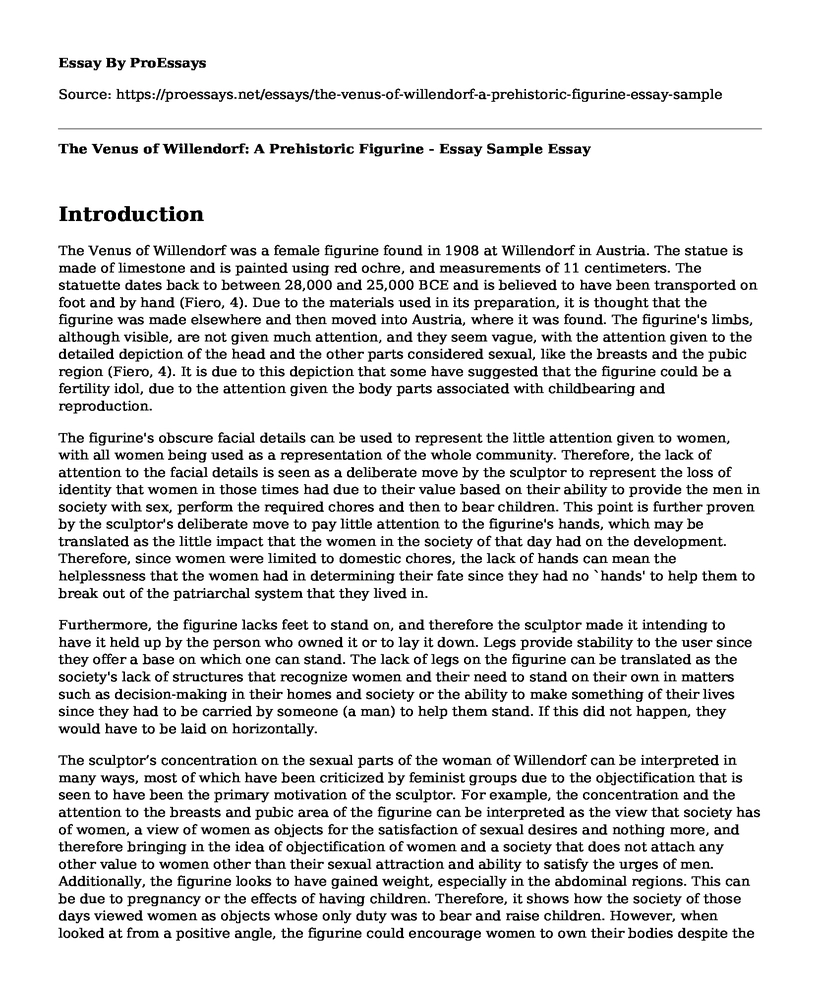Introduction
The Venus of Willendorf was a female figurine found in 1908 at Willendorf in Austria. The statue is made of limestone and is painted using red ochre, and measurements of 11 centimeters. The statuette dates back to between 28,000 and 25,000 BCE and is believed to have been transported on foot and by hand (Fiero, 4). Due to the materials used in its preparation, it is thought that the figurine was made elsewhere and then moved into Austria, where it was found. The figurine's limbs, although visible, are not given much attention, and they seem vague, with the attention given to the detailed depiction of the head and the other parts considered sexual, like the breasts and the pubic region (Fiero, 4). It is due to this depiction that some have suggested that the figurine could be a fertility idol, due to the attention given the body parts associated with childbearing and reproduction.
The figurine's obscure facial details can be used to represent the little attention given to women, with all women being used as a representation of the whole community. Therefore, the lack of attention to the facial details is seen as a deliberate move by the sculptor to represent the loss of identity that women in those times had due to their value based on their ability to provide the men in society with sex, perform the required chores and then to bear children. This point is further proven by the sculptor's deliberate move to pay little attention to the figurine's hands, which may be translated as the little impact that the women in the society of that day had on the development. Therefore, since women were limited to domestic chores, the lack of hands can mean the helplessness that the women had in determining their fate since they had no `hands' to help them to break out of the patriarchal system that they lived in.
Furthermore, the figurine lacks feet to stand on, and therefore the sculptor made it intending to have it held up by the person who owned it or to lay it down. Legs provide stability to the user since they offer a base on which one can stand. The lack of legs on the figurine can be translated as the society's lack of structures that recognize women and their need to stand on their own in matters such as decision-making in their homes and society or the ability to make something of their lives since they had to be carried by someone (a man) to help them stand. If this did not happen, they would have to be laid on horizontally.
The sculptor’s concentration on the sexual parts of the woman of Willendorf can be interpreted in many ways, most of which have been criticized by feminist groups due to the objectification that is seen to have been the primary motivation of the sculptor. For example, the concentration and the attention to the breasts and pubic area of the figurine can be interpreted as the view that society has of women, a view of women as objects for the satisfaction of sexual desires and nothing more, and therefore bringing in the idea of objectification of women and a society that does not attach any other value to women other than their sexual attraction and ability to satisfy the urges of men. Additionally, the figurine looks to have gained weight, especially in the abdominal regions. This can be due to pregnancy or the effects of having children. Therefore, it shows how the society of those days viewed women as objects whose only duty was to bear and raise children. However, when looked at from a positive angle, the figurine could encourage women to own their bodies despite the societal definition of beauty, with those who do not meet those standards being body-shamed. Therefore, the figurine seems to be flaunting what was previously used against her, as if to say `I am happy with who I am.'
Works Cited
Fiero, Gloria. Landmarks in Humanities. McGraw-Hill Higher Education, 2012.
Cite this page
The Venus of Willendorf: A Prehistoric Figurine - Essay Sample. (2023, Aug 13). Retrieved from https://proessays.net/essays/the-venus-of-willendorf-a-prehistoric-figurine-essay-sample
If you are the original author of this essay and no longer wish to have it published on the ProEssays website, please click below to request its removal:
- The Iliad and the Archaic Greeks - Essay Sample
- Architectural Theories That Have Dominated Western Architecture Essay
- Olaudah Equiano's Autobiography: Slave Trade Era in Africa
- Essay Sample on How I Met Your Mother: A 21st Century Sitcom Sensation
- Movie Analysis Essay on Beverly Hills Cop
- Paper Example on Anonymous Reporting: Finding Your Voice to Stand Against Fear
- Essay Example on Declaring War on Hitler: Should Roosevelt Have Acted Sooner?







